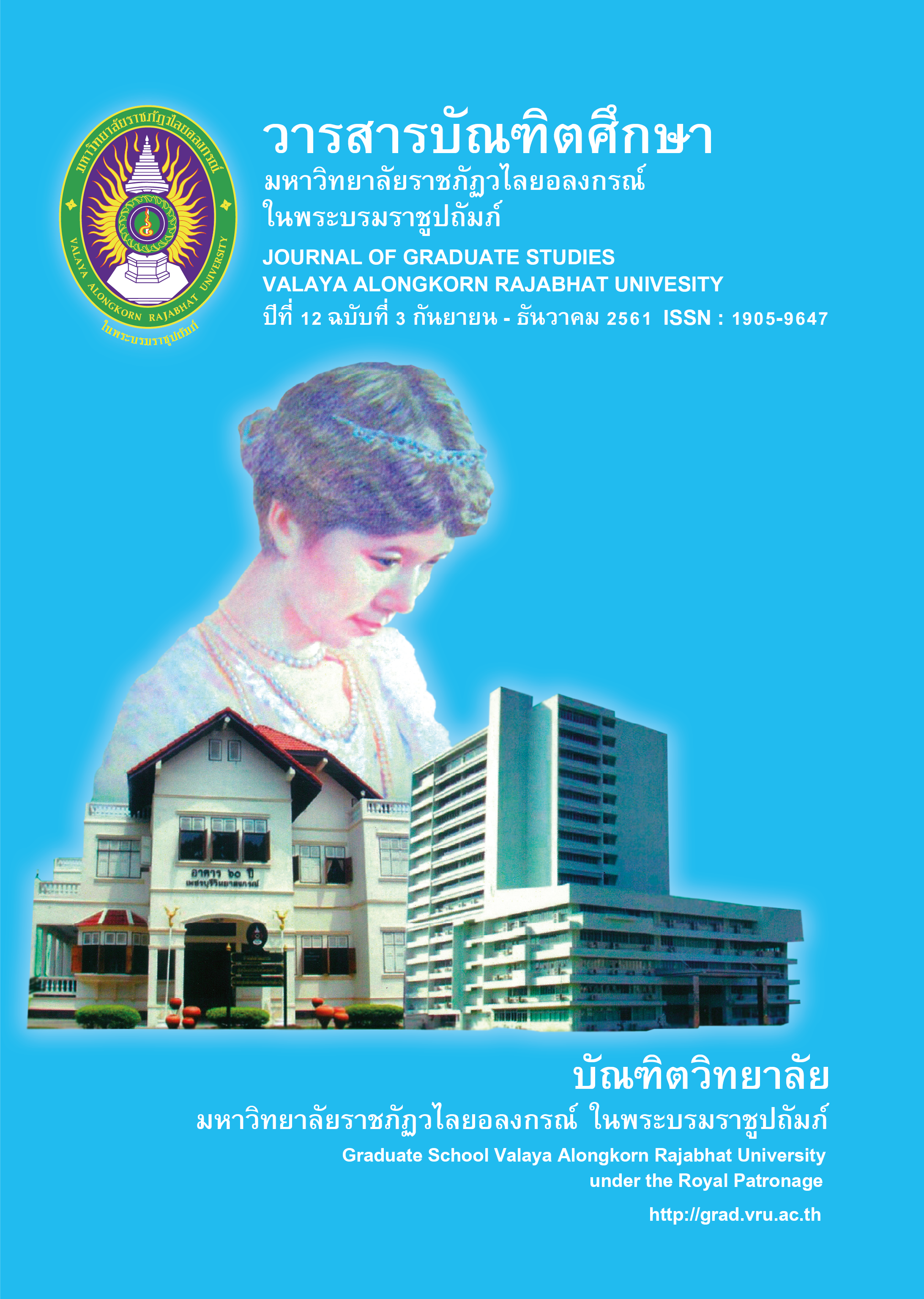CONSTRUCTING CONFIDENCE IN SELF-EFFICACY OF CHILDREN AND YOUTH GROUPS OUTSIDE THE EDUCATIONAL INSTITUTIONS TO BUILD UP THE IMMUNE SYSTEM FOR NACOTIC PREVENTION THROUGH COMMUNITY PARTICIPATION
Main Article Content
Abstract
This research and development aimed: 1) to develop a program for constructing confidence in children and youth’s self-efficacy, and 2) to evaluate the effectiveness of the program outside the institution in order to build up immune system and narcotic prevention through community participation. The research was conducted in 3 districts of Kamphaeng Phet Province divided into 3 phases including: the first phase was to develop the program through focus group discussion among 30 people and 30 children and youth outside the institution; the second phase was to try out the program; and the third phase was to evaluate the effectiveness of the program. Upon 3 districts, the samples of the second and the third phases consisted of 30 people and 40 children and youth outside the institution in each district. Instruments used were a questionnaire and form for focus group discussion which were verified by the experts. Data were analyzed using percentage, mean, standard deviation, and paired t-test as well as content analysis for qualitative data.
The findings of the research were that:
1) The program was developed in two phases. The first phase was done by a workshop among the community people, children, and youth outside the institution for 2 days. The first day was to build confidence in the children and youth’s self-efficacy as well as to make the people understand their children and youth’s capacity. The second day was to create brainstorming by participation among the people, children and youth regarding community activities/projects which possibly implemented in the community. The second phase was to evaluate the program effectiveness.
2) From evaluation of the program effectiveness revealed that the confidence in self-efficacy of the children and youth and the participation of the people, children and the youth after engaging the program were higher than those of before with statistical significance at the 0.05 level. Based on program expansion in their areas, the children and youth had implemented 32 projects in their communities with 720 participants. The projects were group-working activities supported by the community people. Some activities were participated by the community people as guest speakers. In conclusion, satisfactions among the participants while project expansion were at the high level.
Article Details
บทความทุกเรื่องได้รับการตรวจความถูกต้องทางวิชาการโดยผู้ทรงคุณวุฒิ ทรรศนะและข้อคิดเห็นในบทความวารสารบัณฑิตศึกษา มหาวิทยาลัยราชภัฏวไลยอลงกรณ์ ในพระบรมราชูปถัมภ์ มิใช่เป็นทรรศนะและความคิดของผู้จัดทำจึงมิใช่ความรับผิดชอบของบัณฑิตวิทยาลัย มหาวิทยาลัยราชภัฏวไลยอลงกรณ์ ในพระบรมราชูปถัมภ์ กองบรรณาธิการไม่สงวนสิทธิ์การคัดลอก แต่ให้อ้างอิงแหล่งที่มา
References
กิตติวงค์ สาสวด และปรีชา ดิลกวุฒิสิทธิ์. (2559). การพัฒนารูปแบบการป้องกันการแพร่ระบาดของยาเสพติดในกลุ่มเด็กและเยาวชนในเขตพื้นที่เทศบาล อำเภอเมือง จังหวัดฉะเชิงเทรา, วารสารชุมชนวิจัย, 10(1), 116-124.
ธนัชชา รอดกันภัย และเสน่ห์ บุญกำเนิด. (2560). การสร้างภูมิคุ้มกันทางสังคมของเยาวชนกลุ่มเสี่ยง กรณีศึกษานักศึกษา กศน. ตำบลควนทอง อำเภอขนอม จังหวัดนครรีธรรมราช. วารสารนาคบุตรปริทัศน์, 9(2), 132-140. สืบค้นจาก https://www.tci-thaijo.org/index.php/nakboot/issue/view/9260.
ปาจรีย์ ผลประเสริฐ. (2556). ปัจจัยเชิงสาเหตุของพฤติกรรมเสี่ยงด้านสารเสพติดในเด็กและเยาวชนในเขตอำเภอเมือง จังหวัดกำแพงเพชร. วารสารศรีปทุมปริทัศน์มุนษย์ศาสตร์และสังคมศาสตร์, 11(1), 89-96. สืบค้นจาก
https://dspace.spu.ac.th/bitstream/123456789/2121/10/10.pdf .
พระสุทัศน์ พันธุ์ศุภผล. (2559). รูปแบบการดําเนินงานเฝ้าระวังป้องกันและแก้ไขปัญหายาเสพติดของเทศบาล และองค์การบริหารส่วนตําบลจังหวัดชลบุรี. วารสารวิทยาลัยนครราชสีมา. 10(1), 184-195. สืบค้นจาก
https://journal.nmc.ac.th/th/admin/Journal/2559Vol10No1_24.pdf.
เพ็ญศรี ฉิรินัง. (2559). แนวทางการป้องกันปัญหายาเสพติดในชุมชน พื้นที่เขตหนองแขม กรุงเทพฯ.วารสารวิจัยมหาวิทยาลัยเวสเทิร์น มนุษยศาสตร์และสังคมศาสตร์, 2(1), 39-49.
วรางคณา จันทร์คง และปาจรย์ ผลประเสริฐ. (2561). แนวทางการสร้างภูมิคุ้มกันและป้องกันยาเสพติดในกลุ่มเด็กและเยาวชนนอกสถานศึกษา ในจังหวัดกำแพงเพชร. วารสารกฎหมายสุขภาพและสาธารณสุข, 4(1), 65-74.
วราภรณ์ กุประดิษฐ์ นีออน พิณประดิษฐ์ และศรินทิพย์ รักษาสัตย์. (2551). การพัฒนาการรับรู้ความสามารถของตนเองและการควบคุมตนเองเพื่อหลีกเลี่ยงการใช้สารเสพติดในเยาวชน, วารสารมหาวิทยาลัยราชภัฎมหาสารคาม, 2(2), 93-106.
วลัดดาวัลย์ เชาว์วิวัฒน์. (2556). อะไรคือ สาเหตุที่เยาวชนเกี่ยวข้องกับสิ่งเสพติด. สืบค้นจาก https://nctc.oncb.go.th/ewt_news.php?nid=369&filename=index. สำนักงาน
คณะกรรมการการศึกษาขั้นพื้นฐาน. (2556). แนวทางการจัดกิจกรรมพัฒนาทักษะชีวิตเพื่อการสร้างภูมิคุ้มกันปัญหายาเสพติด. กรุงเทพฯ: ห้างหุ้นส่วนจำกัด โรงพิมพ์อักษรไทย.
สำนักงานคณะกรรมการป้องกันและปราบปรามยาเสพติด. (2560). แผนปฏิบัติการป้องกันและแก้ไขปัญหายาเสพติด ปี 2560. กรุงเทพฯ: กระทรวงยุติธรรม.
สำนักงานคณะกรรมการป้องกันและปราบปรามยาเสพติด. (2560). รายงานผลการดำเนินงานป้องกันและแก้ไขปัญหายาเสพติด ประจำปีงบประมาณ 2560. กรุงเทพฯ: กระทรวงยุติธรรม.
เสมอ แสงสนธ์ สุนทรี ดวงทิพย์ และปาจรีย์ ผลประเสริฐ. (2559). ยุทธศาสต์การป้องกันและแก้ปัญหายาเสพติดในเยาวชน โดยชุมชนจังหวัดกำแพงเพชร. สักทอง: วาสารมนุษย์ศาสตร์และสังคมศาสตร์, 22(1), 107-118. สืบค้นจาก https://management.kpru.ac.th/wp-content/uploads/2017/07/fms_research59_26.pdf.
Hawkins, J.D.; Catalano, R.F.; and Arthur, M. (2002). Promoting science based prevention in communities. Addictive Behaviors. 90(5):1–26.
National Institute on Drug Abuse. (2003). Preventing Drug Use among Children and Adolescents : A Research-Based Guide for Parent, Educators, and Community leaders. 2nd. From https://www.drugabuse.gov/sites/default/files/preventingdruguse_2.pdf.


